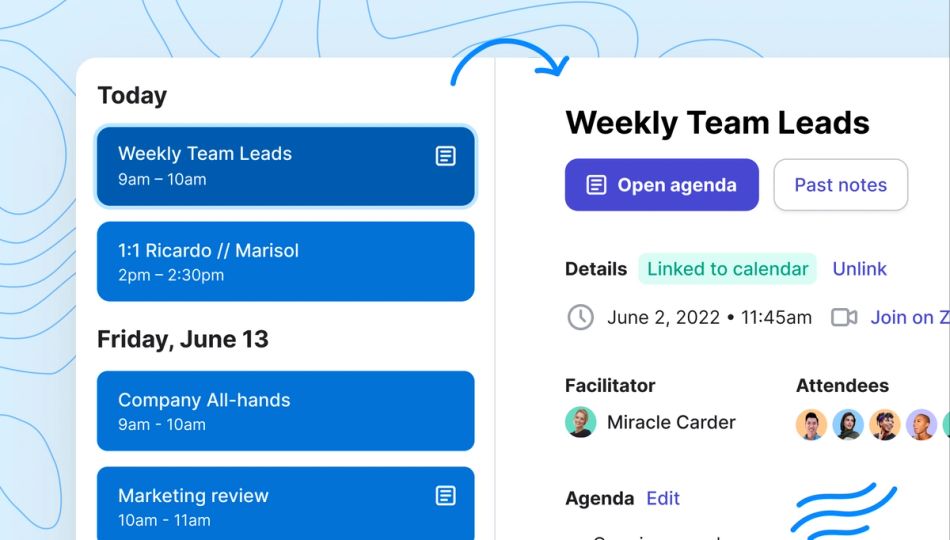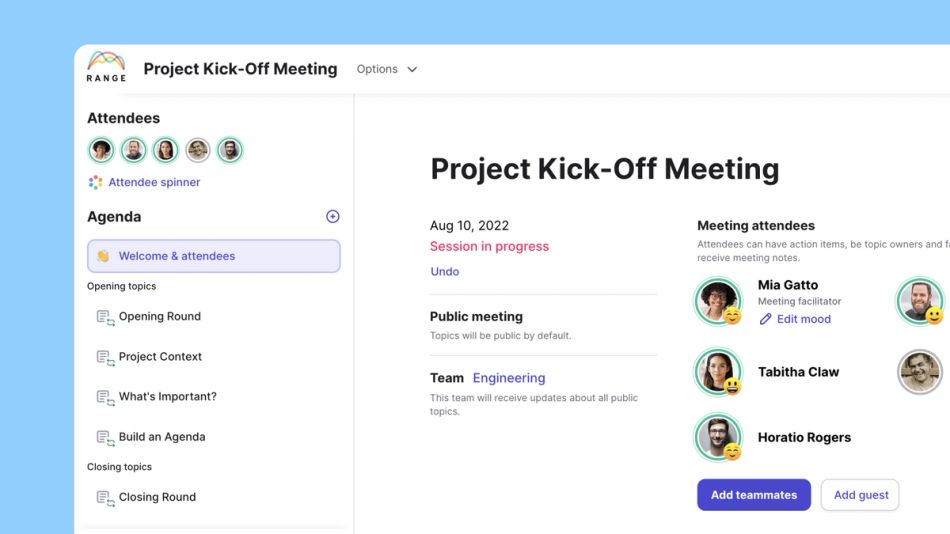
Project review, status updates, and retrospectives are some of the most common types of meetings.
But perhaps the most important is your project kick-off meeting.
This meeting is designed to help everyone hit the ground running on a new project.
When you’re planning for this kind of meeting, make sure that you follow a solid kick-off meeting template so that it goes off without a hitch.
We��’ll show you how.
Step-by-step guide for creating a kick-off meeting agenda
Follow the steps below for an agenda that gets your next project off to a great start.
1. Write a welcoming introduction
If you want to kick the project off just right, then you need to kick the meeting off on the right foot, too. Even though the temptation is to always save time, spend a few minutes at the beginning of the meeting on introductions and icebreakers. This helps facilitate teamwork and build stronger bonds between the project team and the stakeholders.
2. Create a high-level overview of the project background
Once the introductions are out of the way, it’s time to get into the project’s history.
When you’re putting together the project background, be sure to discuss any research behind it or any other factors that led to the project getting the go-ahead to move forward. Explain why the project is needed.
This doesn’t need to be an in-depth analysis of why the project is necessary, or a long retelling of the full backstory.
Keep it high level, and if possible, limit the discussion to two things: the “whys” and the “hows.”
- The “whys” are the pain points, research, or historical context that makes this project a necessity.
- The “hows” include how this project’s completed deliverables will address challenges or pain points.
3. Create a project mission statement
Your project mission statement is the next essential part of the project kick-off meeting. This portion of the agenda should be brief. Your mission statement only needs to be a few sentences that define what the company does and who you’re doing it for.
And, since this is a project mission statement rather than a company-wide mission statement, it should also define the purpose behind the project or the greater project objectives.
The idea behind a project mission statement is to serve as something of a rallying point.
When things get tough, your team members can always come back to look at the mission statement outlined in the kick-off meeting for motivation to push through.
4. Identify and clarify the scope of work
This portion of the meeting is crucial to preventing scope creep — and it needs to happen during this first meeting. Project scope creep happens when last-minute changes to the project result in changing deliverables that require you and your team to spend more of your budget or do more work than initially anticipated.
Prevent this from happening by ensuring that you define not only the things within the scope of the project, but also the things outside the scope. This helps you set expectations — both among your team members and among project stakeholders.
Keep in mind that most projects will evolve naturally as they progress.
Even so, those evolutions should stay within the project’s initial scope so that you don’t run into roadblocks or other issues.

5. Build a project roadmap
Just like you want an itinerary for your vacation plus a map to follow so you don’t get lost, your project needs a roadmap or project plan to help you and your team see it through without getting lost.
It’s relatively simple to create a project roadmap. Start by defining the deliverables for the project, then create milestones to mark bigger accomplishments along the way.
Once you have a set of milestones, plug them into a timeline.
The timeline helps everyone at the meeting understand what needs to happen and when it needs to happen — but remember that your project roadmap is a living document.
As mentioned above, projects can evolve, and your timeline may need to change when they do.
6. Define project roles and team member responsibilities
This part of your agenda is especially important when working with remote teams or team members you may not have worked with before. Defining roles and responsibilities makes everyone’s job clear — and that increases the project's chances of success.
To define roles and responsibilities, ask the following questions:
- Are you working with external partners? If so, what is their role?
- Who is the project’s main point of contact?
- Is there an executive leader or sponsor you must report to?
- Is there an approver, or someone in the group who is in charge of approving deliverables?
Answering these questions will let everyone know who is responsible for what. It’ll also help you to set clear expectations for project goals that need to be met — and the people who will be meeting them — along the path to project completion.
It’s also important to define each of your team members' roles and responsibilities. On the surface, that might seem like a waste of time if you and your team are old pros with an established methodology.
Maybe you've already done many projects together and know who does what. But, this clarifies everything for stakeholders and other external parties who may not be familiar with how your team works.
7. Make tracking & reporting information available to stakeholders
Here’s a shocking fact: At large companies, people spend about 63% of their time on “work about work.”
Work about work are all those tasks you do that help you do tasks related to the project. Like reporting, scheduling, tracking time, and so on.
It’s a huge productivity killer in the office.
And you can minimize all that work about work by making sure that tracking and reporting information is organized and easily accessible to everyone who needs it.
Be sure that your key stakeholders can access it, too. This is a valuable bit of transparency that will help you improve communication and workflow so that you can ensure a successful project. Keep them in the loop on the project timeline, too, so that they know when to expect deliverables.
8. Allow time for questions and feedback
Once you’ve finished the kick-off meeting presentation and any other discussion, be sure to set aside some time for questions and feedback. This gives everyone a chance to get any information they may need that might have been missing from the meeting, for one thing.
It also gives you a chance to refine the project roadmap, the time frame, or any other details. Be open to ideas — your fellow team members can be a great source when it comes to figuring out ways to improve processes.
9. Provide actionable next steps
The final portion of your meeting agenda should be to provide a list of actionable next steps. The project has officially launched now, so where should everyone begin? Make sure to keep detailed meeting notes on this so that you can send them out in a follow-up email later on. This is also a good time to use project management software or your tool of choice to assign and track tasks.
With that, you can conclude the meeting.
The next steps will be in place so your team can get started.
Why are kick-off meeting agendas important, anyway?
Your project kick-off meeting agenda is what will guide the flow of conversation during the project kick-off meeting.
While some meetings cover the broad strokes, this one should be fairly thorough since it gets your new project off to a great start.
It starts with a date, time, attendees, and it should also list the project’s name, kick-off date, and project manager.
From there, the kick-off meeting agenda should cover everything that everyone will need to know about the project:

- Project's purpose
- Project timeline
- Deliverables
- Overview of the scope
- Budget
- Roles and responsibilities
It should also include a space to discuss the next steps to actually kick off the project, plus some time for questions and answers.
That’s what a kick-off meeting agenda looks like — but why is it so important?
- It helps you avoid time wasters that can make a meeting drag on.
- Once you have an agenda, stick with it — and if the conversation starts to steer away from it, then it’s time to put the conversation back on the right track. Remember — these meetings are crucial for getting a project off to a great start.
- An agenda helps you stay on topic, focus on action items, and stay within the timeframe, which sets the pace for the rest of the project.
- Creates meeting accountability. Meeting accountability means everyone in the room is responsible for the meeting and its outcomes. It means the meeting is driven by every attendee — each with an equal role in actively participating and stepping up to take on tasks that help the group get work done.
Use the Range project kick-off meeting template today!
Looking for meeting tools that you can use to improve teamwork and run more efficient meetings? Range is exactly what you need.
Through the Range, you'll have access to a variety of meeting agenda templates to quickly, easily create meetings that stay on task.
With Range, you can:
- Collaborate better with more effective meetings
- Easily facilitate balanced discussions that make every meeting worthwhile
- Keep everyone included and on track with much less effort.
- Build agendas, record actions, and share notes automatically
- Create a recurring agenda for all the topics your team discusses every week from metrics to project updates.
- Empower discussion by building a collaborative agenda & spinning to select others to speak
- Easily document notes from each topic to keep everyone in the loop.
- Share notes via Slack & email








